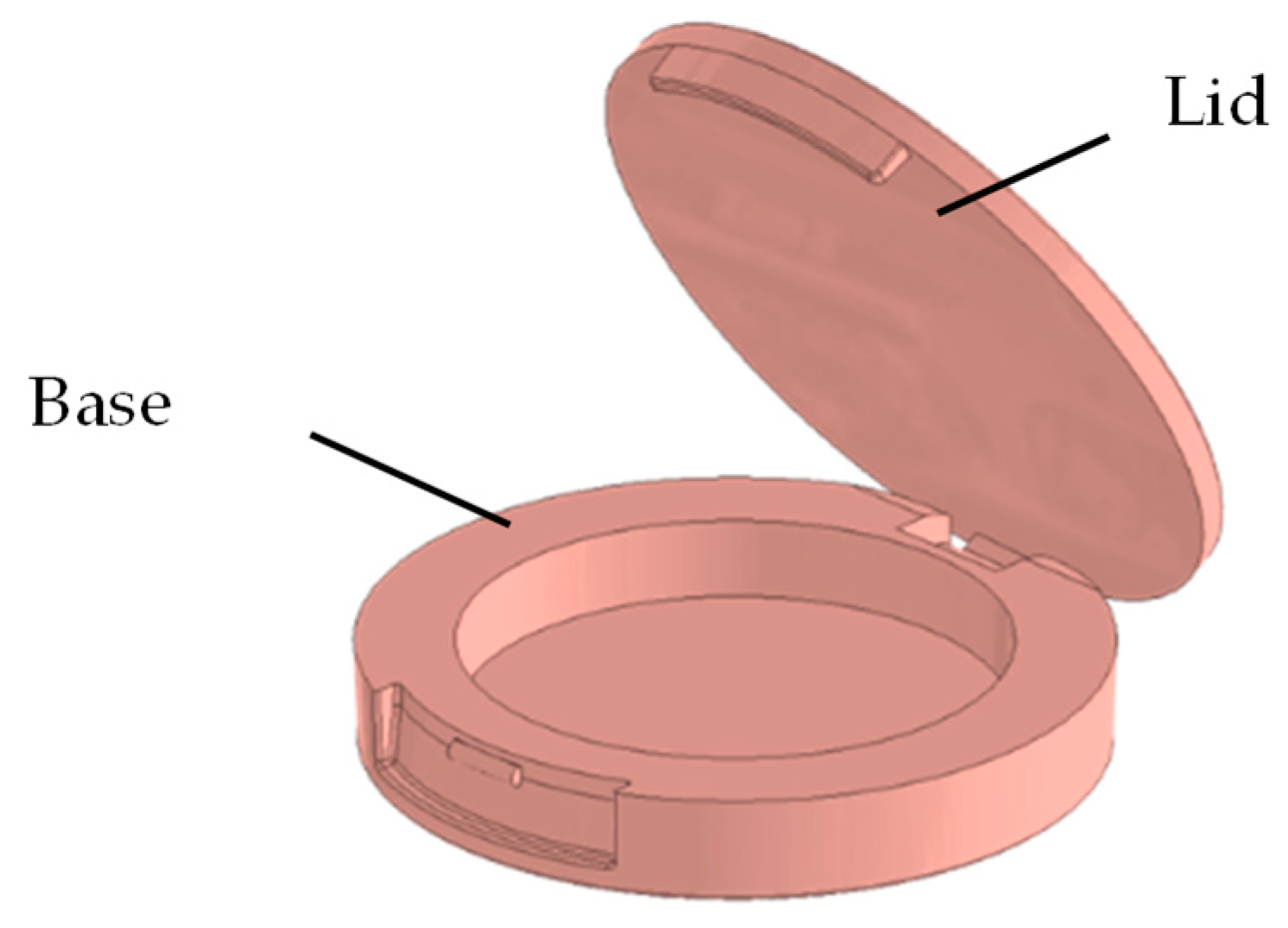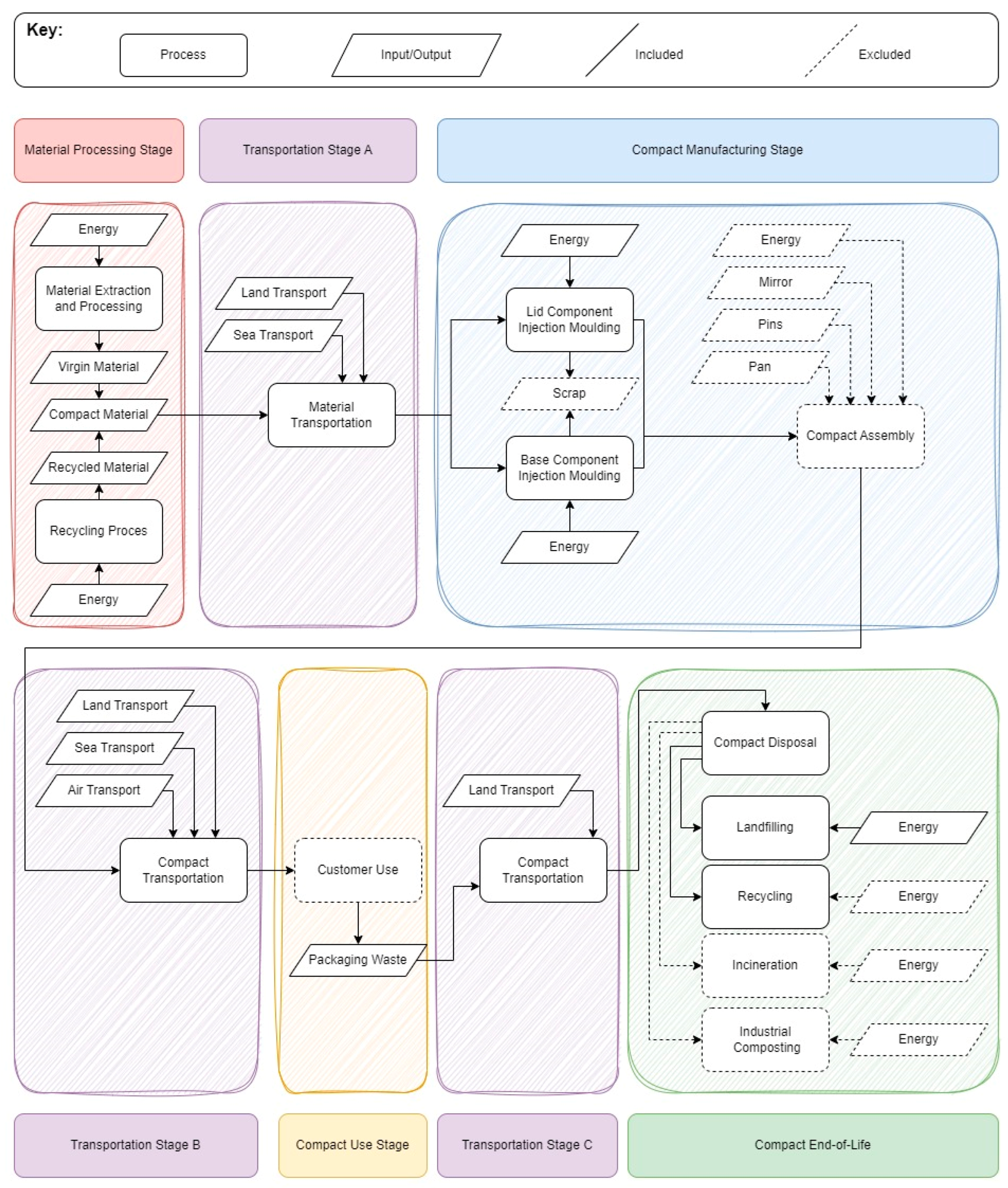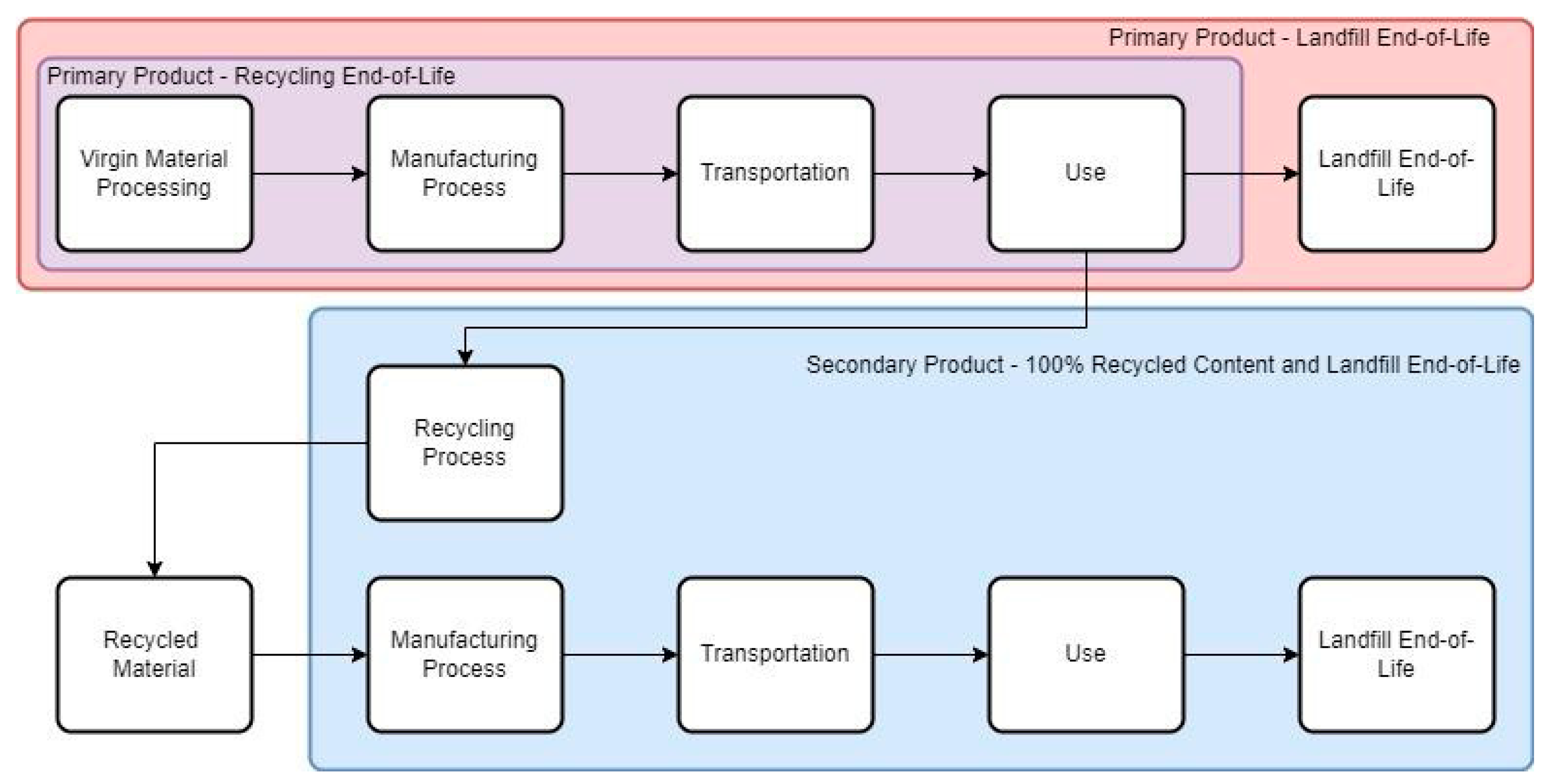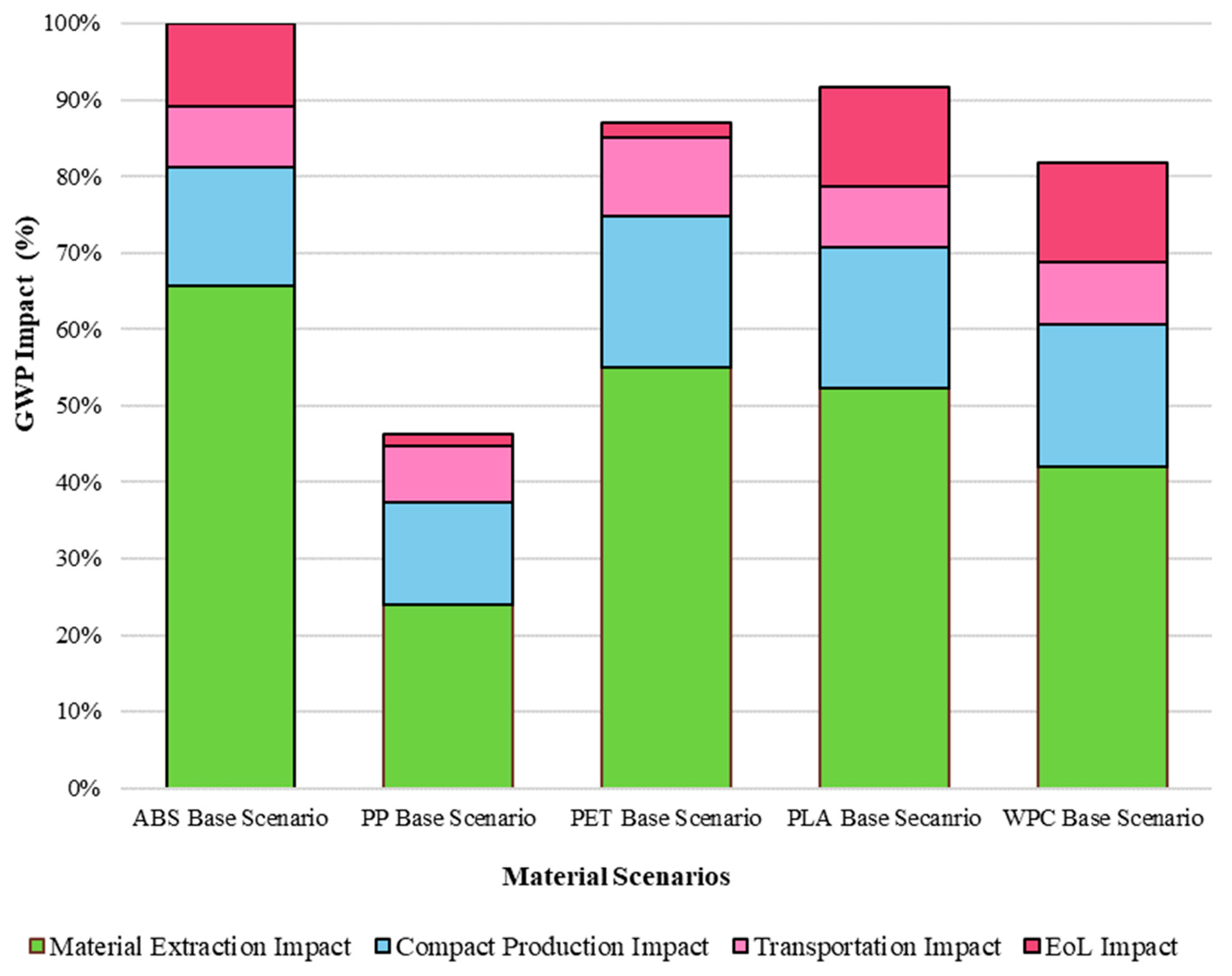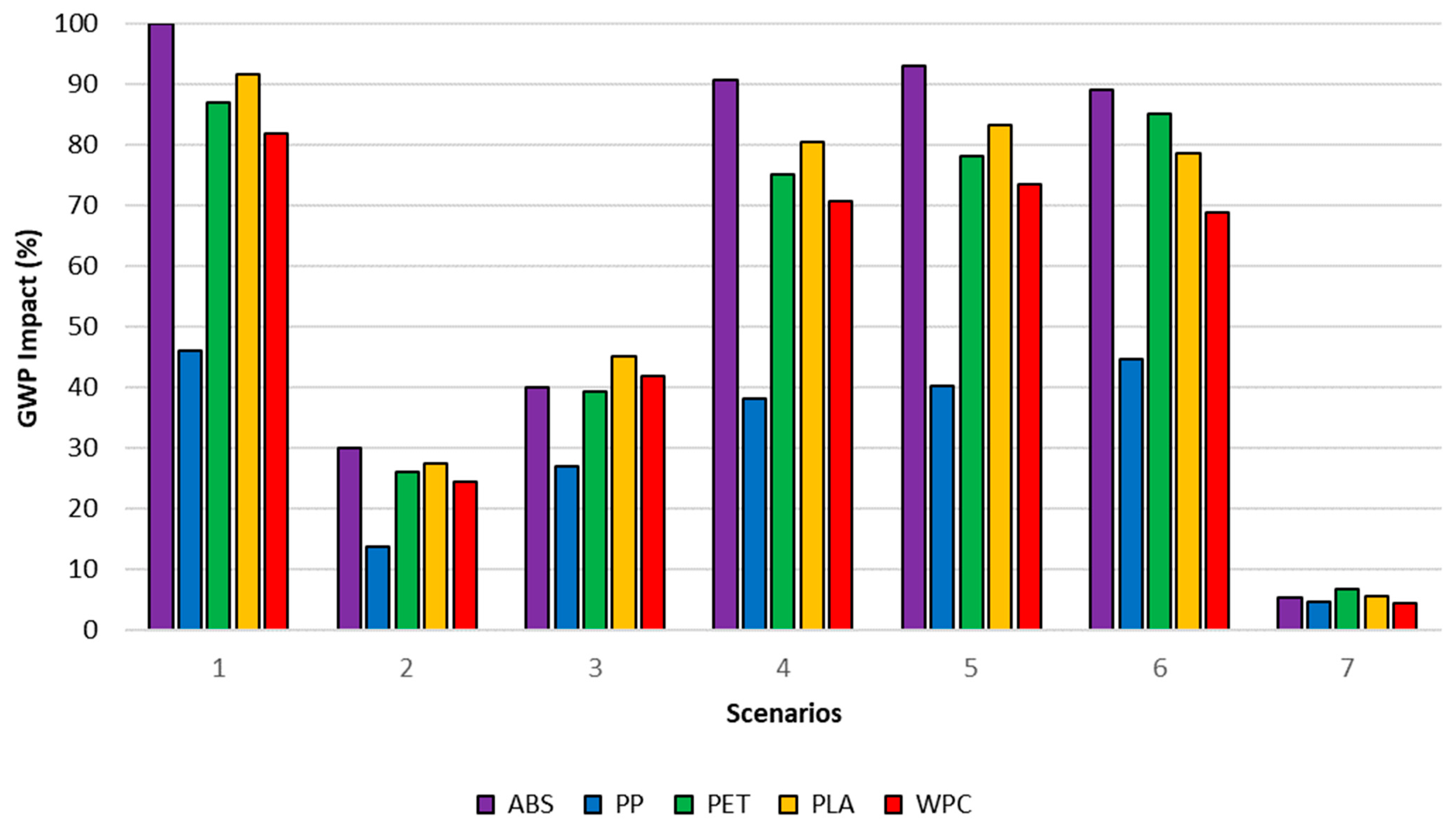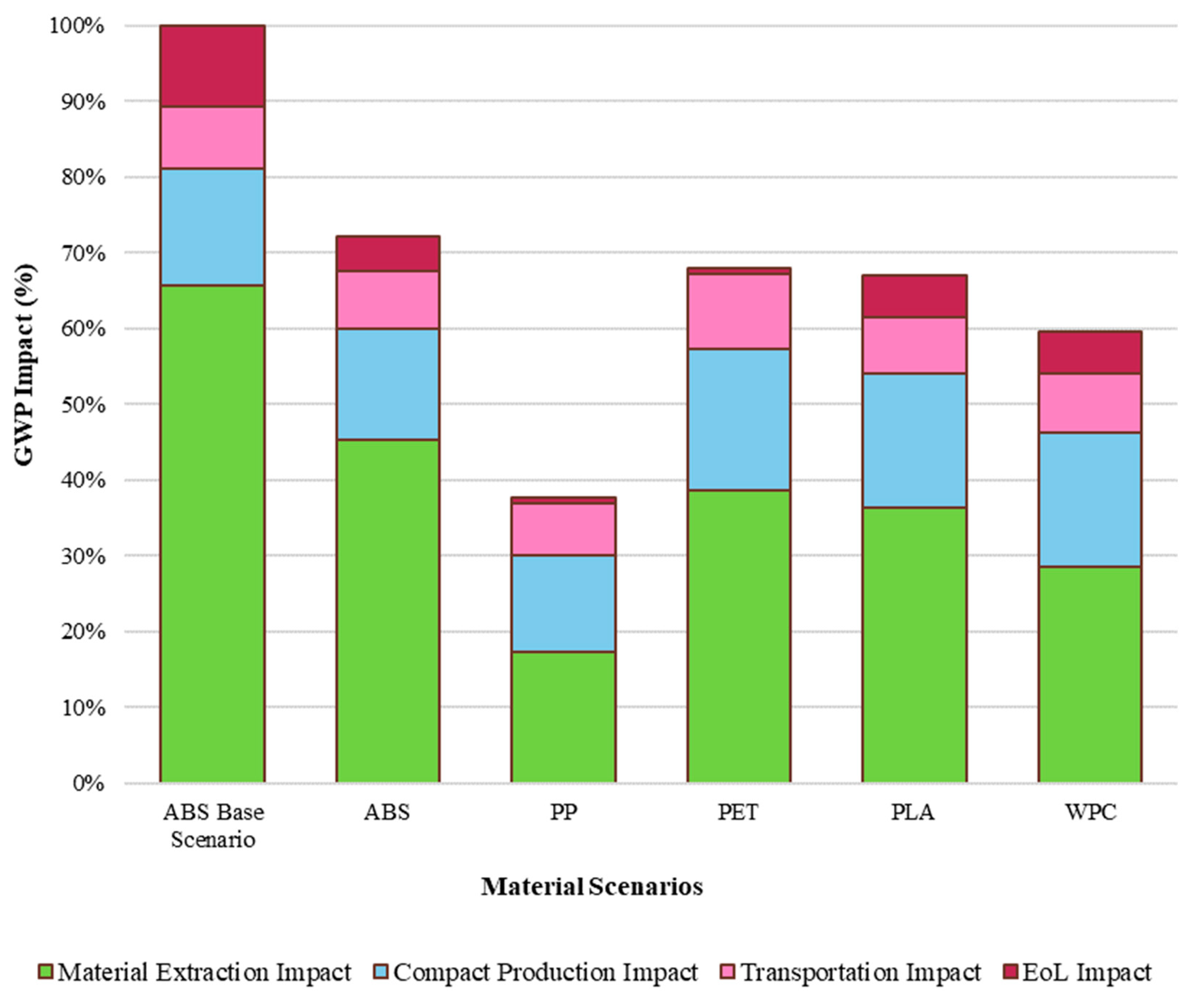1. Introduction
Over the past few years, there has been a steady increase in the demand for cosmetic products, elevating them from luxuries to daily necessities and thriving in the e-commerce market [
1]. This increase in demand has led to significant growth in the global cosmetic packaging market, which is projected to reach EUR 51 billion by 2032 [
2]. Moreover, the growing demand from consumers for sustainable products and the rapidly changing and unpredictable nature of the environment are compelling companies to expand their objectives beyond conventional financial objectives and embrace sustainable practices [
3,
4]. Companies strive to enhance their products and packaging to be more environmentally friendly in response to consumer and environmental demands.
Additionally, there is also a push for sustainable practices through legislation and continental targets. Measures such as the 12th Sustainable Development Goal (SDG), “Responsible Consumption and Production”, and packaging regulations set by the European Commission are aimed at establishing a clear path towards sustainability [
5,
6]. SDG 12 aims to enhance resource efficiency, promote sustainable lifestyles and break the link between economic growth and environmental degradation [
6]. Furthermore, the European Commission has also recently released updated regulations encompassing packaging design and waste management. Among other regulations, the latest Packaging and Packaging Waste Directive states that (i) all packaging must be reusable or recyclable at end-of-life (EoL), (ii) plastic packaging must be 55% recycled at EoL and (iii) packaging waste per capita must be reduced by 5%, all of which are to be achieved by the year 2030 [
6]. In addition to the European targets and goals, European Plastics Producers have proposed the implementation of a 30% recycled content target for plastic packaging, to be achieved by 2030 [
7].
As more businesses strive to incorporate environmental considerations into their products, the process of identifying significant environmental issues associated with the product can be complex. Life cycle assessment (LCA) is a commonly used systematic environmental impact assessment tool covered by the international standard ISO 14044, which takes into consideration different stages of a product’s life cycle from material processing to EoL, including material fabrication, product manufacturing, transportation, use and disposal [
8]. Two common approaches include cradle-to-cradle, where waste at EoL is repurposed, and cradle-to-grave, where waste at EoL is discarded [
9]. An LCA is carried out in four main steps: goal and scope definition, life cycle inventory, life cycle impact assessment and life cycle interpretation. Following the assessment’s completion, the product’s sustainability can be improved by addressing the environmental issues identified [
8,
10].
A sustainable product or packaging meets the needs of the present without compromising the ability of future generations to meet their own needs [
11,
12]. As cosmetic companies are increasingly recognising the value of sustainability and striving to make their packaging more environmentally friendly, it is important to note that different cosmetic brands consider different packaging attributes to improve sustainability. The main cosmetic packaging attributes taken into consideration in the scholarly literature and by various cosmetic brands include the cosmetic packaging quantity, material composition, energy usage and disposal methods at EoL [
13,
14,
15,
16,
17,
18,
19,
20,
21,
22,
23].
In the studies conducted by Uslu et al. and Craft, it was concluded that the weight of the cosmetic packaging has a direct and linear effect on the environmental impact of said packaging [
24,
25]. Cosmetic brands are also exploring different packaging materials, including bio-based and post-consumer recycled (PCR) materials. However, it is important to note that studies that included bio-based materials presented contrasting conclusions on whether bio-based materials generated lower environmental impacts when compared to fossil-based materials. Bengtsson and Logie conducted an LCA to evaluate the best material for popular tertiary packaging used in industry. The study investigated which materials, such as plastic, cardboard, softwood and hardwood, would produce the most environmentally friendly pallet. Pooled pallets (designed to be more durable for reuse) and one-way pallets (typically designed for single-use purposes) of various materials, manufactured in Australia and China, were compared from cradle-to-grave, encompassing material extraction, production, distribution, usage and maintenance and various EoL scenarios. The study demonstrated that the wooden pooled pallets outperformed the pooled plastic pallets in terms of sustainability, irrespective of their manufacturing country. This was mainly attributed to the significant energy quantity required during the pooled plastic pallet manufacturing process. In relation to the global warming potential (GWP), softwood pooled pallets emerged as the most sustainable option, exhibiting an average reduction of 59% in kg CO
2-eq compared to both Australian- and Chinese-manufactured plastic pooled pallets [
26]. Contrastingly, when Craft compared and analysed the environmental effects of cosmetic packaging manufactured from a variety of materials, it was concluded that fossil-based plastics produced the lowest environmental impacts. In his study, Craft compared and analysed the environmental effect of cosmetic packaging using an LCA from cradle-to-grave. Five packaging materials were compared, including fossil-based polymers, namely polypropylene (PP) and high-density polyethylene (HDPE); bio-based polymers, namely polylactic acid (PLA) and polyhydroxyalkanoate (PHA); and aluminium (Al). Despite being fossil-based, PP and HDPE outperformed the other materials in the majority of impact categories [
25]. Similarly, the use of PCR content yielded inconsistent results in terms of beneficial environmental impacts [
24,
26]. PCR content refers to materials that have been previously used by consumers, collected at their EoL, processed and incorporated into a new product. These materials are typically ground into small pellets and repurposed in new products [
27]. In their studies, Uslu et al. and Craft evaluated the environmental impact of cosmetic packaging produced from PCR content [
24,
25]. When Uslu et al. implemented PCR HDPE within the material composition of the cosmetic tube, an average reduction of 29% in the majority of the impact categories was achieved when compared to the original tube. With the application of 100% recycled content, Craft’s results yielded a positive outcome of a 91% reduction in GWP for aluminium [
25]. Conversely, in the study conducted by Bengtsson and Logie, a plastic pallet manufactured in Australia using 100% recycled HDPE had a larger environmental effect than a plastic pallet manufactured in China using 100% virgin plastic. This could be attributed to the diverse manufacturing processes and energy mixes used in the different nations, which in turn have a significant influence on the pallet weight and the associated manufacturing impacts [
26].
Additionally, energy consumption is one of the main concerns highlighted by cosmetic brands and in the literature [
17,
24,
25,
26,
28]. The studies conducted by Uslu et al. and Craft revealed that the raw materials and production stages contribute to more than half of the total effect in the majority of the impact categories [
24,
25]. A recent study conducted by Marczak delved into the specific energy consumption required to produce polymers and highlighted the significant impact of producing 1 kg of polyethylene terephthalate (PET) from raw materials, which required 71.2 MJ of energy. The study recommended the implementation of energy-saving measures and renewable energy sources to mitigate the substantial environmental consequences associated with such intensive energy use [
28].
Moreover, another attribute significantly impacting the environmental impacts of cosmetic packaging is the disposal scenario. In the study conducted by Craft, it was found that 100% recycling at EoL resulted in a 38% and 33% reduction in GWP compared to 100% landfilling, for cosmetic packaging manufactured from PP and HDPE, respectively [
25]. The positive effects of recycling at EoL have also been noted by various cosmetic brands, which are constantly seeking to provide incentives to improve the cosmetic packaging recycling rates. L’Oréal and Burt’s Bees have take-back programmes, which encourage customers to bring back empty cosmetic containers and provide prepaid mailing labels as incentives [
20,
21]. The Body Shop and Lush have implemented an alternative strategy to encourage customers. The Body Shop has a Return, Recycle, Repeat programme in place that invites consumers to return five empty plastic cosmetic packaging containers for EUR 5 in shop credit [
22]. Similarly, Lush has a Bring It Back recycling scheme that motivates consumers to return Lush plastic packaging in exchange for a fresh face mask or store credit that can be utilised on the same day [
23].
The key message from the market and the literature studied is that the cosmetic industry has a significant negative impact on the environment due to the high demand for cosmetic products and their packaging. Cosmetic brands are making various efforts to improve sustainability, but the problem of cosmetic packaging waste persists. Literature studies highlight the discrepancies between results, attributed to different influencing factors such as the product type, the location of manufacture, the methodology and approaches applied in the evaluation and many more. Although there are various studies evaluating sustainable initiatives individually, the scientific body of literature lacks thorough assessments that evaluate and compare various sustainable initiatives comprehensively. The gap between the literature conclusions and the approaches taken by different cosmetic brands highlights the necessity for further research and a comprehensive evaluation of the environmental impact of cosmetic packaging. This involves comparing the effects of different attributes through conducting an LCA. Additional research is crucial to identify and implement more effective strategies aimed at reducing the environmental impact of cosmetic packaging.
The present study aims to evaluate the environmental impacts of cosmetic packaging by investigating the influence of five different packaging factors, namely the volume, material composition, recycled content, energy usage and disposal methods, by carrying out an LCA. As the scholarly literature and various cosmetic brands prioritise different attributes to promote sustainability in their packaging, this study intends to determine which attributes and initiatives are the most impactful, hence requiring further investigation and focus to improve the sustainability of cosmetic packaging.
3. Results and Discussion
This section includes the results and a discussion of the main findings of this study.
3.1. Base Scenario Results
An LCA was conducted on the base scenarios for all five materials considered in this study. A base scenario was formulated by assuming all factors in
Table 2 as zero and that the compact was fully landfilled at end of life. This was carried out to determine the difference in environmental impact between the materials. The results were then utilised as a reference point to compare the impact influences of other factors studied. As expected, the ABS benchmark case produced the largest impact in terms of GWP, which was equal to 103,050 CO
2-eq.
Figure 4 depicts the results for each material normalised to the ABS base scenario.
The results showed that the environmental impact in the material processing phase was highest for the compact made from ABS, which was equal to 67,700 CO
2-eq. This is due to the fact that the chemical compounds used in the production of ABS create a significant amount of hazardous waste and chemicals in comparison to other materials [
37].
There are minor variations in the environmental impacts generated during the manufacturing stage among the different material scenarios. The software employs a standard injection moulding process with general energy consumption values. As a result, the discrepancy is directly related to the weight of the compact being produced, depending on the material density.
The environmental impact of transportation is influenced by both the distance travelled and the weight of the material. It is important to note that the PP compact scenario has the least impact in the transportation phase due to the low density of the material. This results in a smaller mass being transported to produce two million compacts. As a result, PET, which is the material with the highest density being examined, has the greatest environmental impact in the transportation stage, with an impact equal to 10,730 CO2-eq, approximately 30% higher than that of PP.
There is a significant difference in the environmental impacts at EoL among the various materials, with GWP values ranging from 1570 to 13,400 CO2-eq. This was mainly attributed to the lack of material-specific EoL impact data available in the database. PP and PET are widely used; hence, their infrastructure and respective impacts were available on SimaPro, which resulted in lower GWP impacts at the EoL stage when compared to the other materials, which were classified as miscellaneous materials and assigned municipal waste treatment impacts. The lack of material-specific data resulted in a magnitude difference in landfill impacts between the materials.
When comparing the base scenarios, it is evident that PP is the most environmentally friendly option, reducing the impacts by more than 50% from the ABS benchmark case. The second most favourable material was the WPC scenario, which produced a total GWP impact that was two thirds higher than that of PP. Following WPC are PET and PLA, and last is ABS, which generates the highest environmental impact.
3.2. DOE Results
Following the DOE methodology described in
Section 2.2, the study deduced the results for thirty-two scenarios for each material.
Table 3 includes a description of eight informative scenarios analysed.
Figure 5 depicts a visual representation of the impacts generated for each material in each of the scenarios.
As expected, the results indicated that applying 70% dematerialisation resulted in a 70% reduction in total impact for each material. The study’s findings confirm the direct linear relationship between mass and GWP, similar to the findings obtained in various studies, such as those by Uslu et al. and Craft [
24,
25].
The implementation of 100% recycled content resulted in an average total impact reduction of 52%. The compact manufactured from ABS benefited the most from this case scenario, experiencing a reduction of 60% from the total impact, while the least impacted compact scenario was that produced from PP, which still underwent a significant total impact reduction of 42%. The findings of this study were consistent with the findings of the studies conducted by Uslu et al. and Craft, which both determined that implementing recycled content would reduce the environmental impact of cosmetic packaging [
24,
25], The implementation of recycled content mostly benefits the material with the highest impact in the material extraction and processing stage, which, in this study, was ABS. It stands to reason that materials with the lowest impact in the material extraction and processing stage would benefit the least from using recycled content. The conclusions discussed in Craft’s [
25] and Marczak’s [
28] studies were consistent with this conclusion. Similarly, when considering the effect of recycled content on the total impact experienced in this study, this statement holds.
The manufacturing stage had an average contribution of 22% to the total environmental impacts in the cosmetic packaging base scenarios. Hence, the reduction in total impacts ranged between 9 and 17% when the maximum limit (100%) of the renewable energy share was applied. Furthermore, another attribute behind the lower environmental benefits of using solar energy to manufacture cosmetic packaging is the negative environmental impacts of producing photovoltaic panels. This reduction mostly benefited the scenario where the compact was manufactured using PP, despite it having the lowest recorded impact in the manufacturing stage in the base scenario. This factor had the lowest overall benefit for the compacts manufactured using ABS, as it had much larger impacts unaffected in the other stages, which outweighed the beneficial impact of the renewable energy share.
Similarly, the total impact reduction of the material scenarios ranged between 7 and 13%, despite the energy consumption in the manufacturing stage being halved. The negative impacts in the other stages outweighed the positive impact of energy-saving measures in the manufacturing stage, as in the renewable energy scenario. As observed in the renewable energy scenario, the compact made from PP material would benefit the most from this scenario, while the one made from ABS would have the least benefit.
The use of the cut-off approach in this study resulted in the omission of burdens at the EoL stage. This allocation method promotes the use of recycled content over the recycling disposal scenario. The reason is that the positive and negative effects of recycling are completely disregarded at the product’s EoL stage, which is omitted in the recycling disposal scenario. It is worth noting that this method allocates the effects of recycling to the product using the recycled material, and this is why the EoL stage would be omitted in such a case. It is assumed that recycled content originates from waste at the EoL of other products. As a result, the only negative impact allocated within the material processing stage for a product fully manufactured using recycled content is that of the recycling process that produced said material. Therefore, this approach resulted in lower benefits for all material scenarios that were 100% recycled at EoL when compared to the benefits of using 100% recycled content.
The study revealed that by applying 100% recycling at EoL, the total impact reduction of all the material scenarios varied between 2 and 16% when compared to the base scenarios. Since the environmental impacts allocated in the EoL stage were disregarded, WPC, the material with the highest impact in a landfill EoL scenario, benefited the most from recycling at the disposal stage. It is crucial to note that the overall benefits of recycling at EoL are also dependent on the impacts of other stages. Although the PP compact had the lowest environmental impact in the EoL stage, it experienced a slightly larger overall impact reduction than the PET compact, which had a larger impact in the EoL stage. The ratio of the impacts at other stages on the total impact accounts for this.
It is worth noting that all materials examined in this study are recyclable, but not all of them are typically recycled in municipal recycling programs. Materials such as ABS and bioplastics are typically incompatible with conventional recycling processes, which is attributed to material property variability [
38]. Nonetheless, high rates of recycling and recycled content for all materials were considered in this study, as an indication of future potential.
As can be noted in
Figure 5, the most impactful factor was dematerialisation, which was followed by recycled content. For the scenarios ranging from 1 to 6, PP was the most environmentally friendly material, consistently yielding an average of 46% lower environmental impacts than the other materials. In the scenario whereby all the factors were maximised (scenario 7), WPC emerged as the least environmentally impactful material, with an average 17% reduction in impact compared to the other materials. The existing literature has examined specific factors in the assessment [
24,
25,
26]; hence, such analysis provided further insights into the advantages of employing combined factors. The Pareto analysis highlighted the impact of both individual and combined factors, arranged in ascending order from the most to the least effective.
Figure 6 provides a snapshot of the Pareto chart. It features factors whose values exceed the critical value line, indicating their substantial impacts on the overall environmental footprint of the cosmetic compact. It is crucial to note that the remaining factor combinations did not have a significant impact, failing to cross the critical value line, and were consequently excluded from the figure.
The Pareto chart provides conclusive evidence that each individual factor has a notable impact on the overall environmental impact, aligning with the findings from earlier sections. Additionally, the chart reveals that six distinct factor combinations, including one combination involving three factors (dematerialisation, renewable energy share and energy-saving measures), are also significant based on the study’s results. Notably, dematerialisation emerges as the factor with the greatest influence on GWP, as expected. Among the factor combinations, the one incorporating dematerialisation and recycled content stands out as the most effective combination. These findings suggest that cosmetic companies should focus primarily on reducing the amount of packaging and substituting virgin materials with post-consumer recycled content. By implementing these measures, the reduction in the environmental impact of cosmetic packaging in terms of GWP would be substantial.
3.3. Results Based on the 2030 Packaging Regulations and Targets
The impacts of the cosmetic compact were evaluated to identify the most sustainable material based on the targets set by the European Commission and European Plastics Producers for the year 2030. These targets include implementing a minimum of 30% recycled content in packaging, reducing the compact volume and hence the compact waste by 5% and achieving a minimum of a 55% recycling rate at the EoL stage [
6,
7].
On average, all materials experienced a reduction in the total impact of around 24%. This scenario included 5% compact material volume dematerialisation, where all the material stages experienced the expected 5% reduction in impact. Additionally, when implementing 30% recycled content, all the materials experienced an average reduction of 27% in the material processing stage. Each material experienced a further reduction of 55% at the EoL stage.
Figure 7 depicts the environmental impact at each life cycle stage for all the materials based on the 2030 targets normalised to the ABS base case. Despite experiencing the smallest overall impact reduction in this scenario, a compact manufactured using PP would produce the lowest environmental impact in terms of GWP, with a total of 38,772 CO
2-eq.
5. Conclusions
This study identified key factors impacting packaging sustainability, as highlighted in the literature and emphasised by popular cosmetic brands. These factors include sustainable practices such as reducing the packaging quantity, selecting materials with a focus on biodegradability and incorporating recycled content, increasing the use of renewable energy, minimising the energy consumption during packaging manufacturing and determining appropriate disposal methods at EoL. Subsequently, an LCA was conducted to evaluate the effects of these influencing factors. The assessment was carried out on the base scenarios for all the materials, to both identify the most sustainable material in the case when none of the studied factors were applied and to serve as a reference point for a comparison of the impact reductions when applying said factors. The ABS benchmark case was found to have generated the highest environmental impact, reaching 103,050 CO2-eq. The results obtained in this study suggest that if cosmetic companies only focus on changing the packaging material to reduce its overall impact, without altering any other packaging attributes, then PP would be the most environmentally friendly material. By replacing ABS with PP, the environmental impact of cosmetic packaging can be reduced by over 50%.
For all the material scenarios, the life cycle stage with the greatest share in the total impact was the material processing stage, which, in every case, made up more than half of the total environmental impact. The impacts generated in the compact manufacturing stage varied slightly between materials due to the standard injection moulding process with general energy consumption values. The transportation impacts were influenced by the distance and material weight, resulting in PP, the material with the lowest density, having the lowest impact in the transportation phase. Differences in EoL impacts were significant, mainly due to a lack of material-specific EoL data. PP and PET, with available recycling infrastructure data, exhibited lower GWP impacts at the EoL stage compared to materials categorised as miscellaneous with municipal waste treatment impacts. One of the main conclusions drawn from the results of the base scenarios is that cosmetic companies, while still striving to reduce the environmental impact of packaging throughout its entire life cycle, should prioritise efforts to reduce the environmental impact of cosmetic packaging in the material processing stage. Therefore, it is recommended that companies conduct further evaluations and analysis of their supply chain and its respective environmental impacts.
Various scenarios implementing individual and combined factors were also evaluated and the findings revealed several noteworthy insights. As expected, dematerialisation had a substantial impact, resulting in a linear reduction in the environmental impact for each material, reaffirming prior studies’ observations regarding the direct relationship between mass and GWP. Implementing 100% recycled content yielded a significant impact reduction for all the material scenarios. Notably, the material with the highest impact in the material processing stage, ABS, benefited the most when virgin material was replaced with recycled content.
It is interesting to note that while the conversion to renewable energy and the application of energy-saving measures during manufacturing, as well as recycling at EoL, resulted in a reduction in the overall impact of the cosmetic packaging, the reduction was not as significant as the application of dematerialisation and recycled content. This was attributed to the different stages of the life cycle being affected and their share in the overall impact. The introduction of a 100% renewable energy share and energy-saving measures during manufacturing had varying impacts, with PP gaining the greatest benefit in both cases. Similarly, incorporating 100% recycling at EoL had varying results for different materials. WPC, with the highest landfill EoL impact, saw the most significant reduction. The analysis carried out in this study found that all the different packaging attributes considered had a positive impact on the environmental footprint of the cosmetic packaging. This suggests that the current approaches taken by cosmetic companies are indeed generating beneficial effects. However, the results obtained also make it clear that some approaches, such as reducing the material volume and switching from virgin material to recycled content, would be more effective in reducing the environmental impact of cosmetic packaging.
It is crucial to note that ABS had the highest environmental impact in all the scenarios that were considered in the analysis. Surprisingly, despite the prevailing industry trends favouring bio-based materials, this study underscores the superior environmental performance of PP, a fossil-based plastic, in the majority of cases. WPC consistently ranked second to PP in terms of GWP, except in scenario 7, where all factors were maximised. These findings underscore the potential for strategic choices in material selection to significantly enhance the environmental sustainability of cosmetic packaging.
A Pareto analysis shed further light on the effects of individual and combined factors of cosmetic packaging sustainability, which was consistent with prior findings. Six key factor combinations were identified as having substantial effects on the overall impact. Specifically, the combination of dematerialisation and recycled content emerged as highly effective, further emphasising the importance of reducing packaging and incorporating PCR materials.
This analysis offers valuable guidance for cosmetic companies seeking to enhance the sustainability of their packaging. The primary focus should be on three key areas: reducing the packaging volume, selecting appropriate materials and replacing virgin materials with PCR content. As demonstrated repeatedly in this study, dematerialisation emerges as a critical factor. Companies should prioritise reducing packaging quantities while ensuring that such reductions do not compromise product integrity. Neglecting this aspect might lead to increased waste production and, consequently, more adverse environmental impacts, resulting in an overall detrimental effect on the environment. Furthermore, when packaging remains a necessity, the use of PCR materials to replace virgin materials is highly recommended. This strategic shift could contribute to an additional impact reduction, resulting in more environmentally friendly packaging. Employing these measures, cosmetic companies will in turn comply with SDG 12, the European Commission regulations and the Packaging and Packaging Waste Directive targets.
